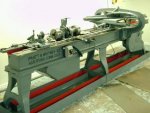Just curious, does anyone know the rifling method used to make 1903 as well as Garand barrels? I know that button rifling wasn't totally perfected by Mike Walker until the late 40s-early 50's, so pre-WW2 rifles definitely didn't have button rifled barrels. Hammer forging AFAIK was developed by the Germans right around WW2. So that means MOST 1903 and Garand barrels were either single point cut or broach cut rifled... does anyone know which one? If I had to guess I'd say broach cut since its much faster than single point..
@Frank Green possibly might know??
@Frank Green possibly might know??






